45-70 Ballistics Charts From Every Major Ammunition Manufacturer
Congratulations! You found our in-depth look at 45-70 ballistics from the leading ammo manufacturers.
Save time by clicking the links below to jump to your preferred ammo company and find the ballistics specs you need for your favorite 45-70 factory load.
45-70 Ballistics Charts
Jump to an ammo company: Barnes | Choice | Federal | Fiocchi | Hornady | Remington | Sellier & Bellot | Underwood | Winchester
Barnes Ammunition Ballistics Charts - 45-70 Govt.
Jump to a ballistics chart: Barnes 45-70 Govt 300 grain TSX FN | Barnes Pioneer 45-70 Govt 300 grain TSX FN | Barnes Pioneer 45-70 Govt 400 grain Barnes Original
Barnes 45-70 Govt 300 grain TSX FN Ballistics Chart
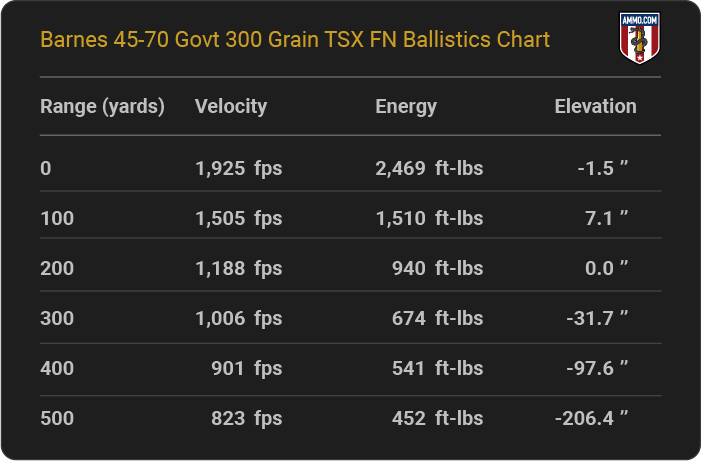
Barnes Pioneer 45-70 Govt 300 grain TSX FN Ballistics Chart
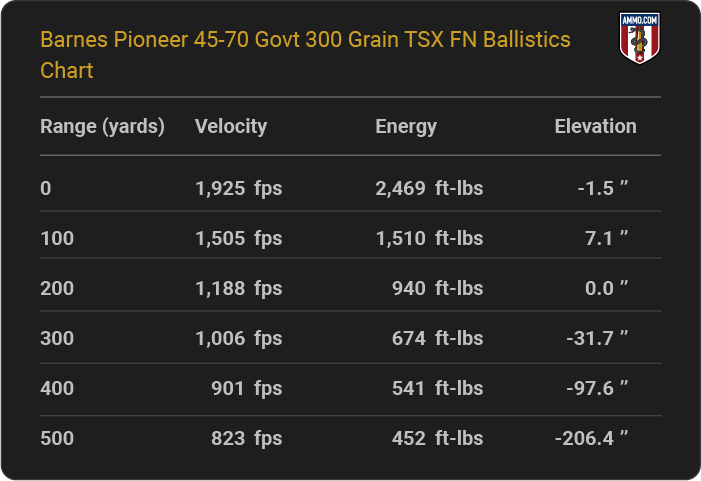
Barnes Pioneer 45-70 Govt 400 grain Barnes Original Ballistics Chart
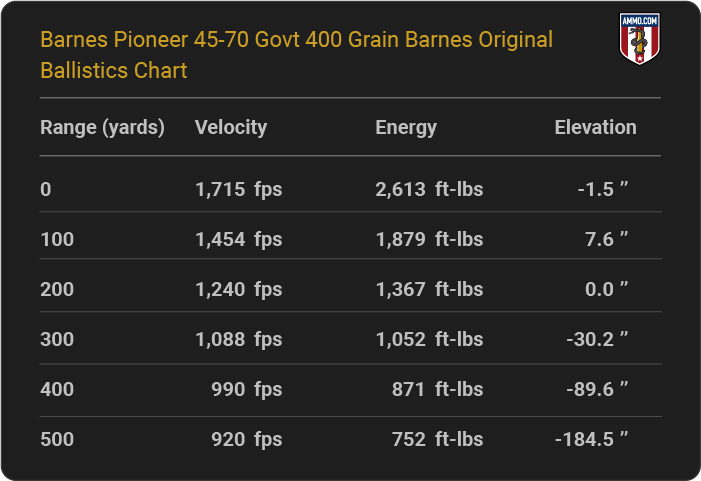
Choice Ammunition Ballistics Chart - 45-70 Govt.
Choice 45-70 Govt 300 grain TSX Ballistics Chart
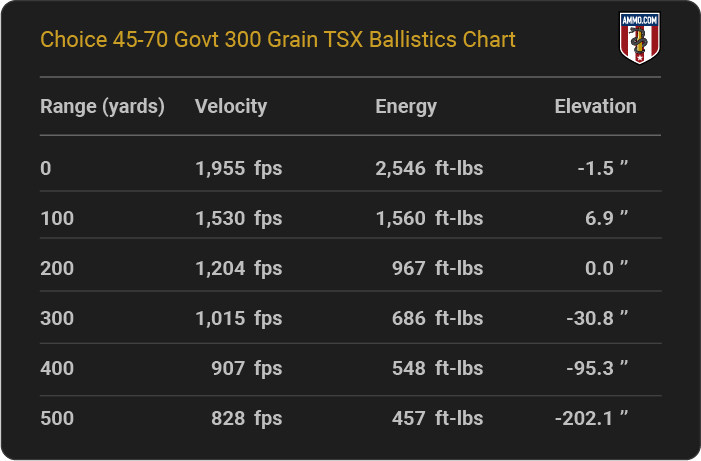
Federal Ammunition Ballistics Charts - 45-70 Govt.
Jump to a ballistics chart: Federal Fusion 45-70 Govt 300 grain Bonded SP | Federal HammerDown 45-70 Govt 300 grain Bonded SP | Federal Power-Shok 45-70 Govt 300 grain JSP
Federal Fusion 45-70 Govt 300 grain Bonded SP Ballistics Chart
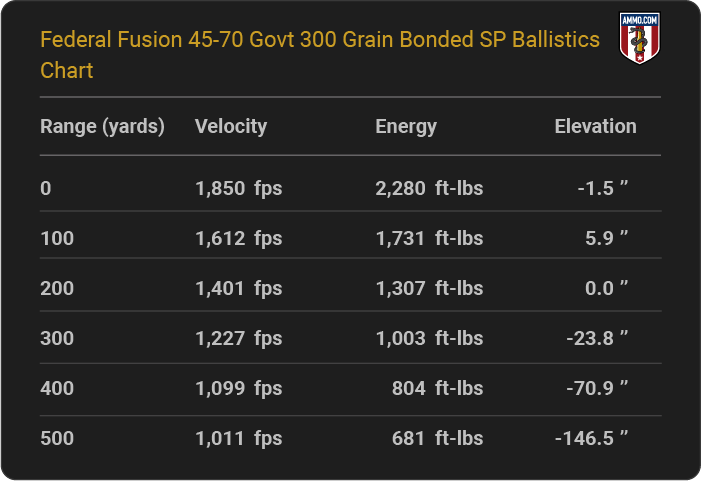
Federal HammerDown 45-70 Govt 300 grain Bonded SP Ballistics Chart
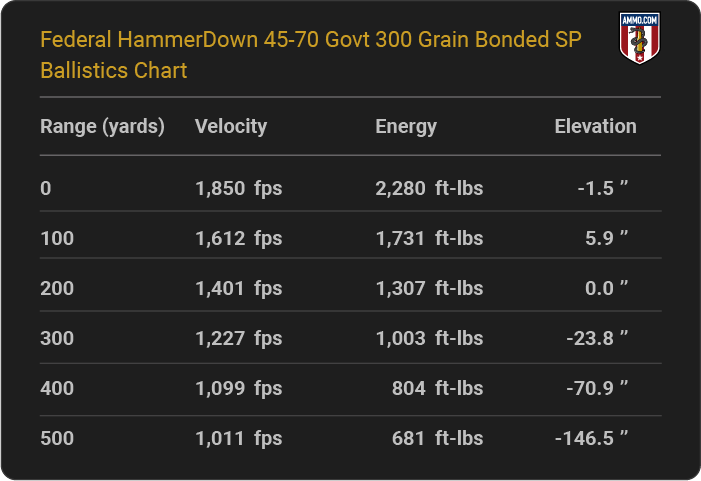
Federal Power-Shok 45-70 Govt 300 grain JSP Ballistics Chart
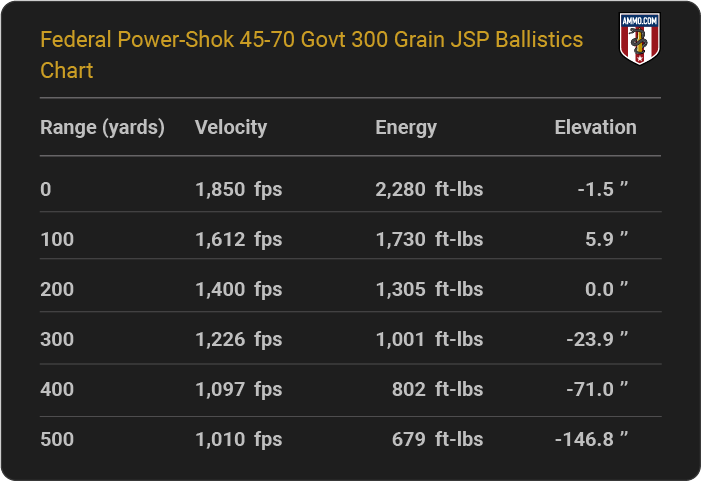
Fiocchi Ammunition Ballistics Chart - 45-70 Govt.
Fiocchi Field Dynamics 45-70 Govt 300 grain HPFN Ballistics Chart
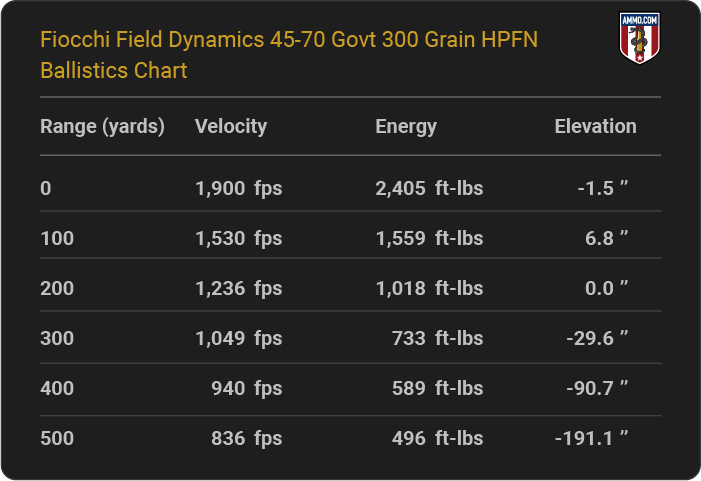
Hornady Ammunition Ballistics Charts - 45-70 Govt.
Jump to a ballistics chart: Hornady LeveRevolution 45-70 Govt 250 grain MonoFlex | Hornady LeveRevolution 45-70 Govt 325 grain FTX | Hornady Subsonic 45-70 Govt 410 grain Sub-X
Hornady LeveRevolution 45-70 Govt 250 grain MonoFlex Ballistics Chart
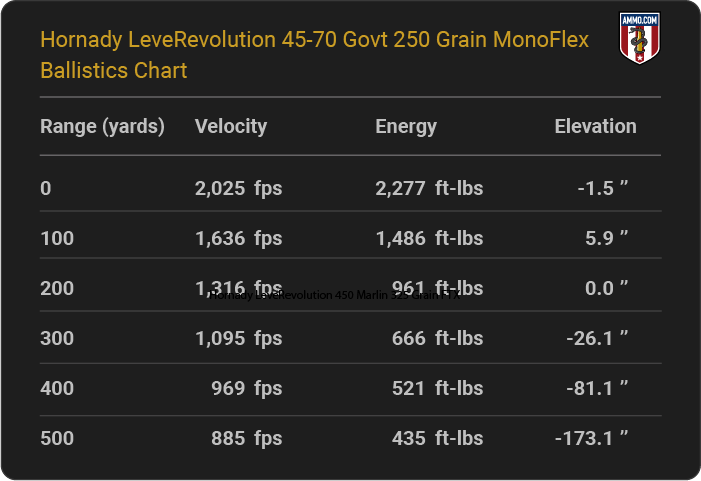
Hornady LeveRevolution 45-70 Govt 325 grain FTX Ballistics Chart
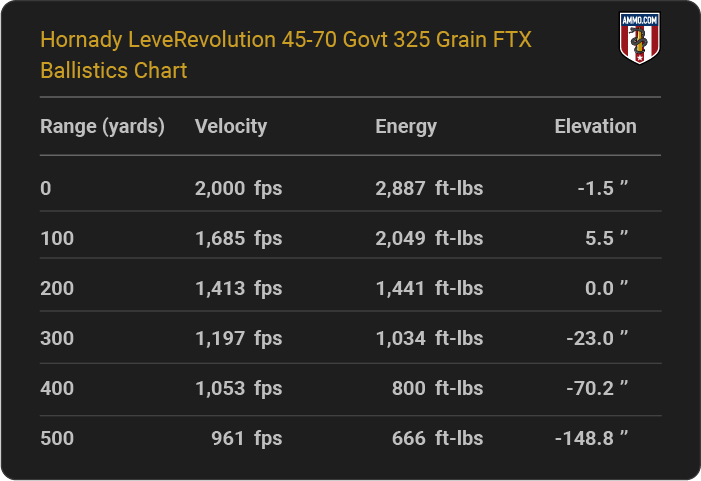
Hornady Subsonic 45-70 Govt 410 grain Sub-X Ballistics Chart
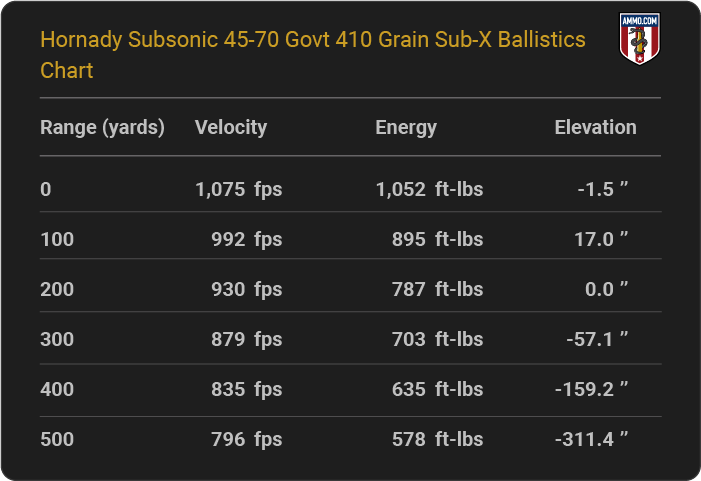
Remington Ammunition Ballistics Charts - 45-70 Govt.
Jump to a ballistics chart: Remington Core-Lokt 45-70 Govt 405 grain SP | Remington High Performance 45-70 Govt 300 grain SJHP
Remington Core-Lokt 45-70 Govt 405 grain SP Ballistics Chart
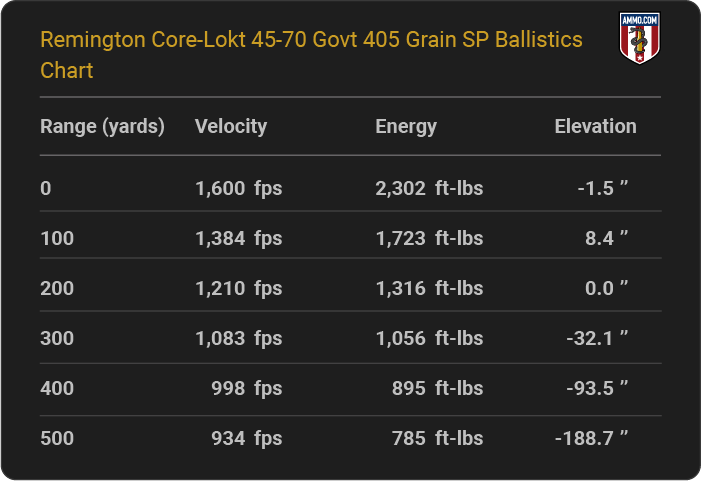
Remington High Performance 45-70 Govt 300 grain SJHP Ballistics Chart
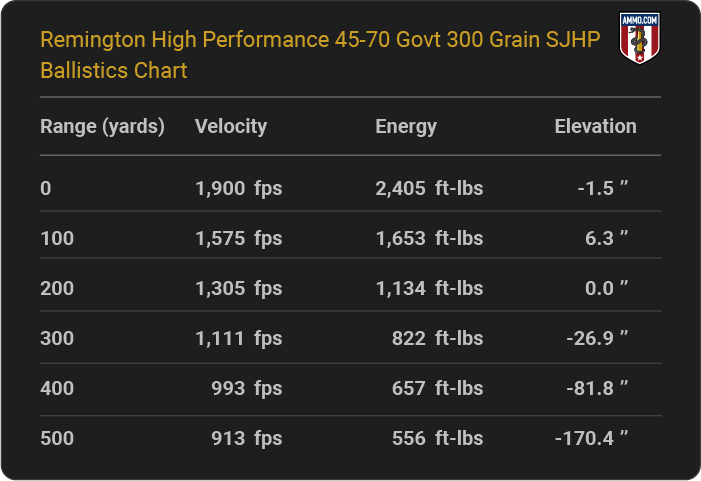
Sellier & Bellot Ammunition Ballistics Chart - 45-70 Govt.
Sellier & Bellot 45-70 Govt 405 grain SP Ballistics Chart
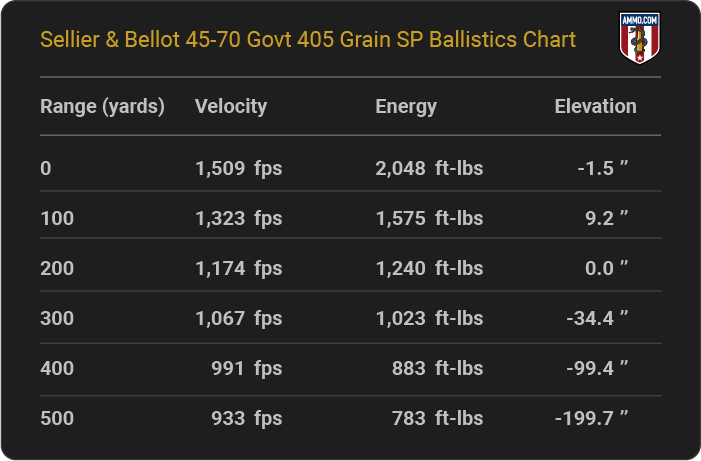
Underwood Ammunition Ballistics Charts - 45-70 Govt.
Jump to a ballistics chart: Underwood 45-70 Govt 300 grain JHP | Underwood 45-70 Govt +P 300 grain JHP | Underwood 45-70 Govt 325 grain Xtreme Hunter Solid Monolithic | Underwood 45-70 Govt +P 325 grain Xtreme Hunter Solid Monolithic
Underwood 45-70 Govt 300 grain JHP Ballistics Chart
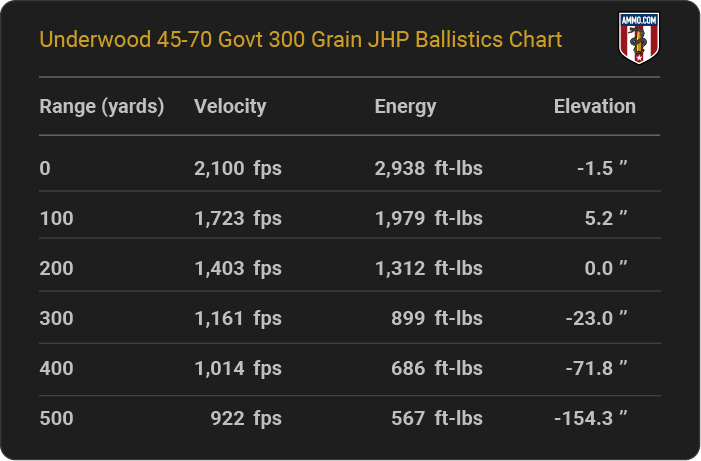
Underwood 45-70 Govt +P 300 grain JHP Ballistics Chart
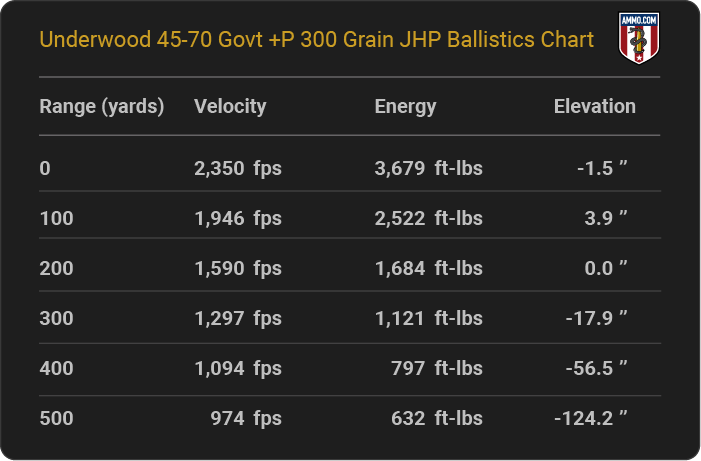
Underwood 45-70 Govt 325 grain Xtreme Hunter Solid Monolithic Ballistics Chart
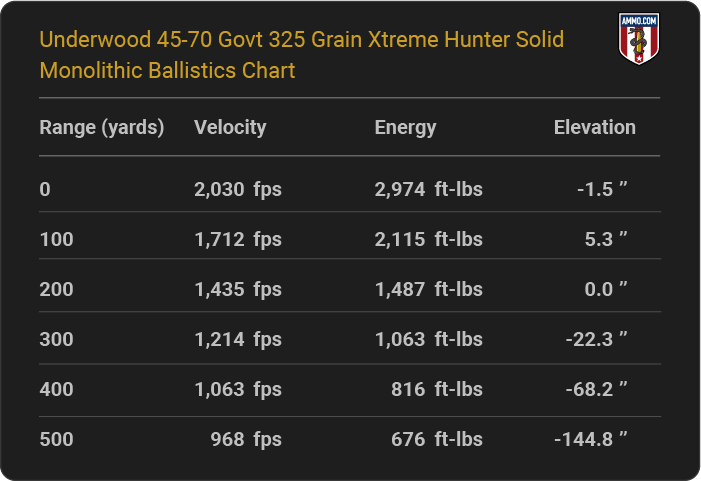
Underwood 45-70 Govt +P 325 grain Xtreme Hunter Solid Monolithic Ballistics Chart
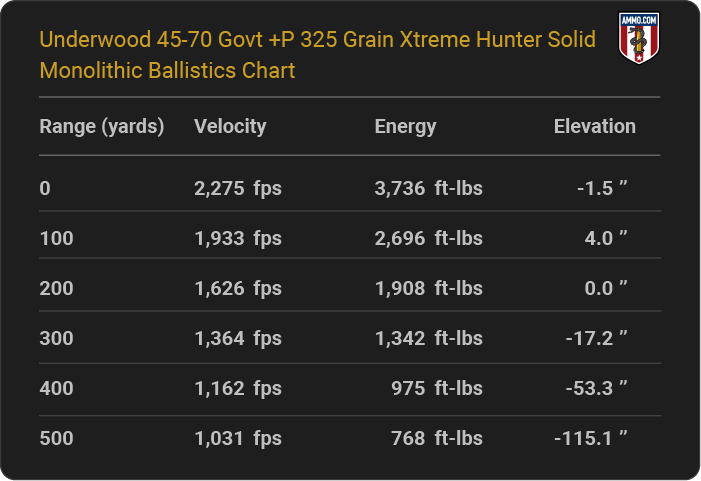
Winchester Ammunition Ballistics Charts - 45-70 Govt.
Jump to a ballistics chart: Winchester Ballistic Silvertip 45-70 Govt 300 grain Polymer Tip | Winchester Super-X 45-70 Govt 300 grain JHP | Winchester Super-X 45-70 Govt 405 grain LFN
Winchester Ballistic Silvertip 45-70 Govt 300 grain Polymer Tip Ballistics Chart
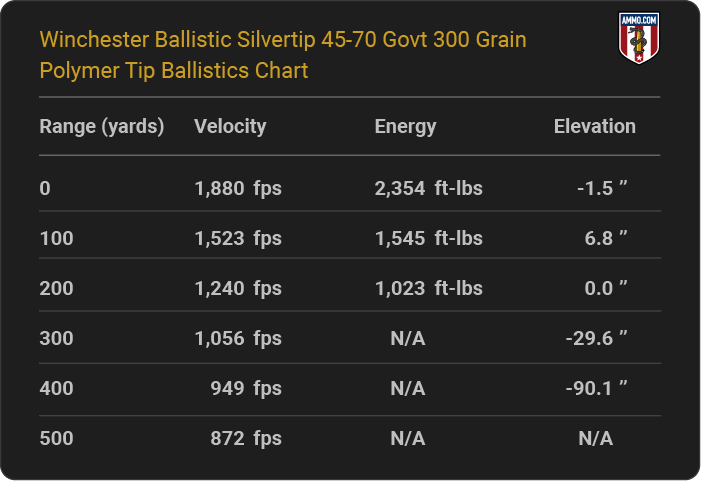
Winchester Super-X 45-70 Govt 300 grain JHP Ballistics Chart
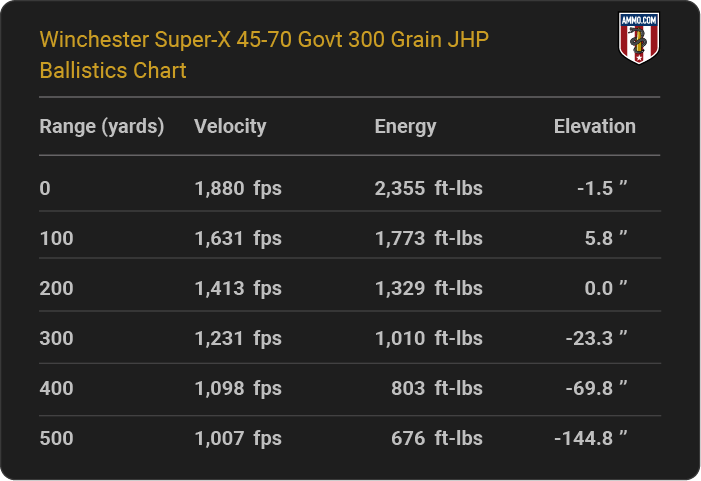
Winchester Super-X 45-70 Govt 405 grain LFN Ballistics Chart
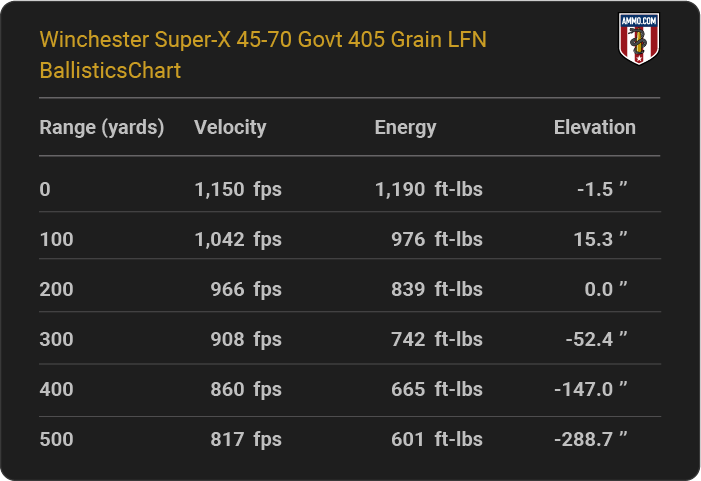
Administrative Note: The information above comes from the manufacturers. The actual ballistics obtained with your firearm can vary considerably from the advertised ballistics. Also, ballistics can vary from lot to lot with the same brand and load. When manufacturer ballistic data were unavailable, they were calculated using a ballistics calculator.
45-70 Trajectory Chart
A bullet’s flight path to the target is also called its trajectory. Shooters measure the trajectory in inches of bullet drop, milliradians (MIL), or minutes of angle (MOA).
A flat trajectory is preferred for long-range shooting because it requires the marksman to make fewer adjustments to compensate for bullet drop. The 308 Winchester and 6.5 Creedmoor cartridges are examples of rifle cartridges with a relatively flat trajectory and projectiles with good ballistic coefficients.
The 45-70 can strike targets at 1,000 yards; however, it does not have a flat trajectory. If you sight in your 45-70 hunting rifle at 200 yards, you’ll shoot nearly 7” high at 100 yards and have about 30” of bullet drop at 300 yards.
Below is a sample 45-70 bullet drop chart that gives a general idea of its trajectory.
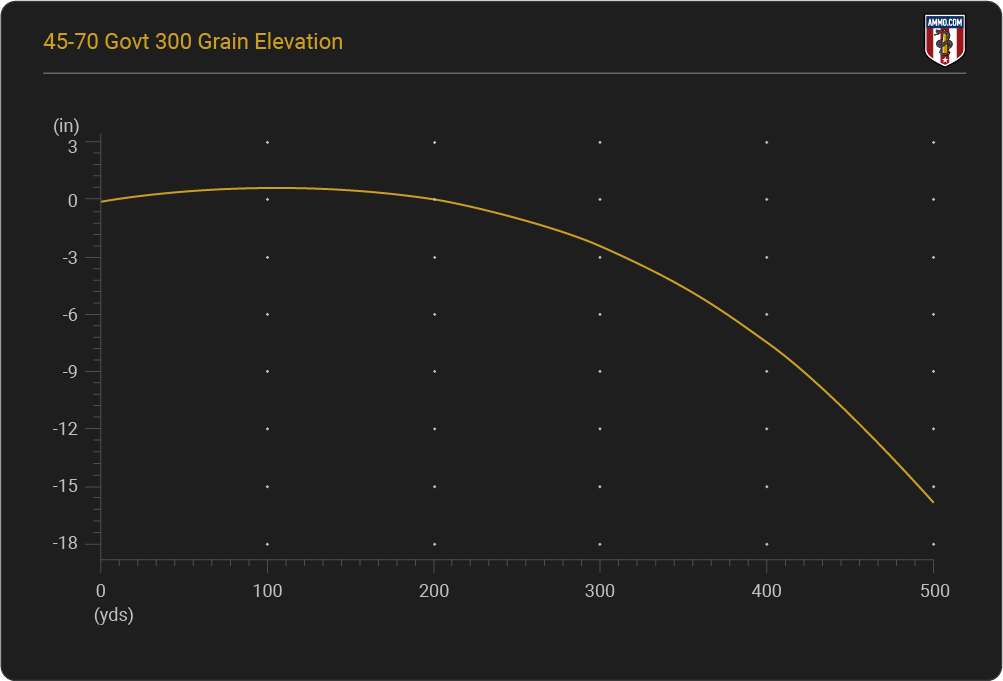
Note: The chart above illustrates the ballistic performance of one 45-70 Government cartridge. Actual ballistic performance will vary depending on bullet weight, lot, barrel length, and environmental conditions while shooting.
45-70 Velocity
The rate at which the bullet exits the rifle’s barrel is its muzzle velocity, measured in feet per second (fps).
A longer 45-70 rifle barrel generally produces a higher muzzle velocity, as it gives igniting propellant more time to exert its energy against the projectile. When a 45-70 Govt. 300 grain bullet is launched from a lever gun with a 16.1-inch barrel (such as the Marlin 1895), its velocity will be lower than the same 300 grain bullet fired from a Henry single-shot rifle with a 22-inch barrel.
Modern 45-70 rifles firing smokeless propellant cartridges also produce higher velocities than antique rifles (such as the Springfield Model 1873) that fire black powder rounds.
Bullet weight and design significantly impact the velocity a projectile will exhibit downrange. For example, lighter bullets tend to have higher velocities than heavier ones, and jacketed hollow point projectiles tend to conserve velocity slightly more efficiently than the soft point bullets traditionally used for big game hunting with lever-action rifles.
Handloaded rounds can achieve higher velocities than factory-loaded ammo, which is one reason why reloading is popular among competitive Cowboy Action shooters. It's also an enjoyable pastime that can save you some money!
The muzzle velocity of a typical factory-loaded 45-70 cartridge ranges from about 1,150 to 2,300 fps, depending on the rifle and exact load it’s firing.
45-70 Energy
A bullet’s energy is measured in foot-pounds (ft-lbs). Muzzle energy is the force a bullet possesses as it exits the rifle barrel.
Heavier bullets tend to have higher muzzle energy, although the projectile’s velocity at impact plays a significant role in determining its actual striking energy.
We can expect a muzzle energy of 2,354 ft-lbs from a 300 grain polymer tip 45-70 Govt projectile, whereas a 400 grain Barnes Original has a muzzle energy of 2,613 ft-lbs.
45-70 Effective Range
My grandpa always wanted a 45-70 Govt because of the scene in Quigley Down Under where Tom Selleck fires his Sharps rifle to hit a buck at around 750 yards. But was the 45-70 actually capable of such a feat – or was that just movie magic?
In addition to magnum handguns loaded with hardcast bullets, the 45-70 is used by North American sportsmen for downing dangerous game such as moose, black bear and brown bear. It’s largely favored because of its large bullet diameter and high energy at close range (200 yards or less). It can also ethically harvest large game animals (elk and moose) at longer ranges (250-300 yards).
When target shooting, the 45-70 is capable of 1,000-yard shots, though its poor trajectory makes it much more difficult than when using a 6.5 Creedmoor or other long-range cartridge.
How do 45-70 Ballistics Compare to Other Rifle Cartridges?
Whether you own a rifle chambered for a different cartridge – or are interested in learning which rounds will outperform or exhibit similar ballistics to the 45-70 Govt. – then you’re in the right place. The team at Ammo.com has already compared the 45-70 to several similar cartridges that are also used for big game hunting.
45-70 vs 444 Marlin Ballistics Chart
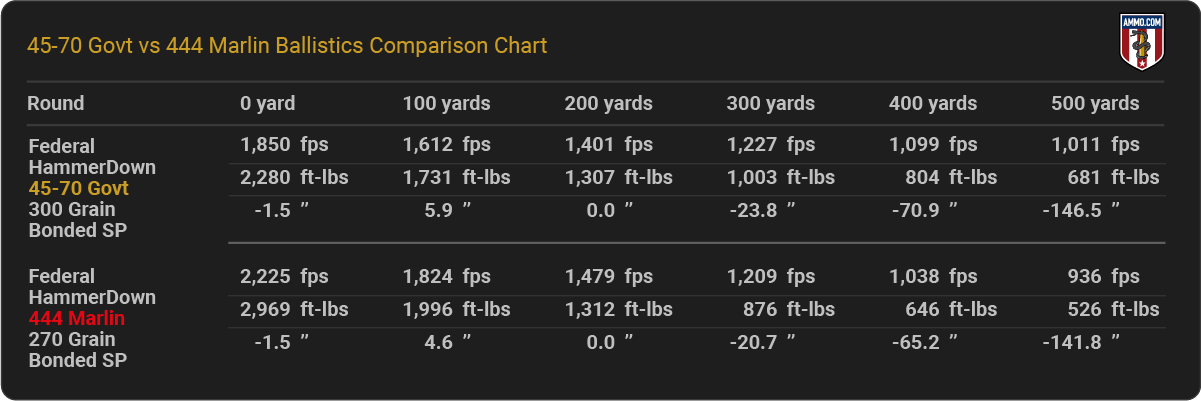
45-70 vs 450 Bushmaster Ballistics Chart

Don’t miss our in-depth look at 450 Bushmaster ballistics.
45-70 vs 30-30 Ballistics Chart
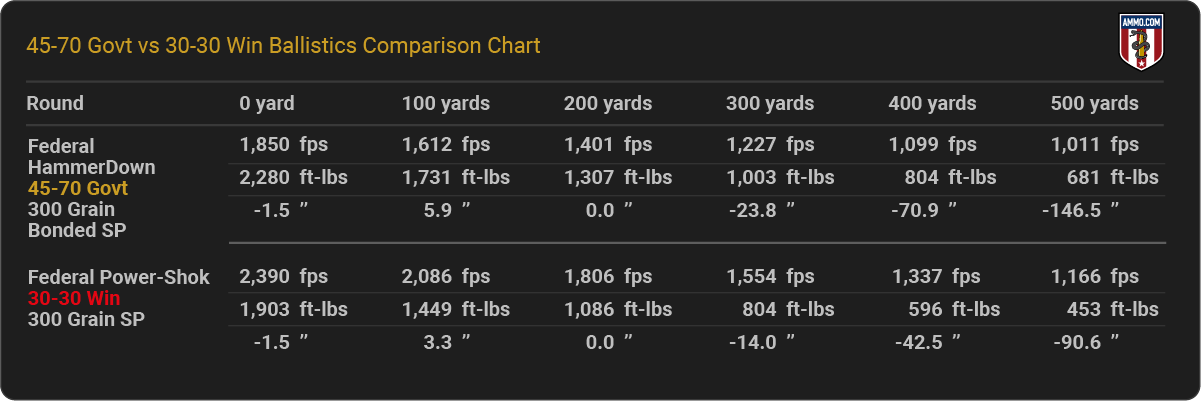
Don’t miss our in-depth look at 30-30 Winchester ballistics.
45-70 vs 450 Marlin Ballistics Chart
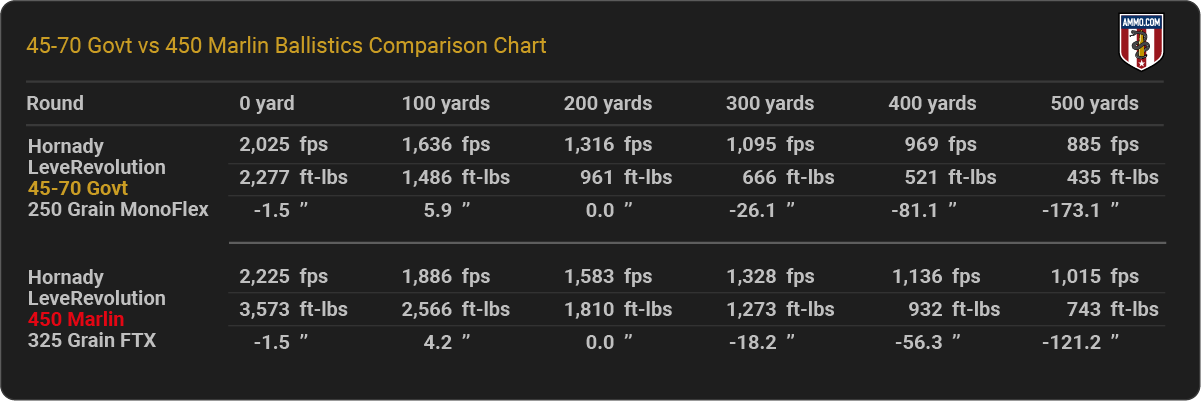
Frequently Asked Questions
The team at Ammo.com has gathered and answered some of the most commonly asked questions regarding 45-70 ballistics. Check it out!
What is the effective range of a 45-70 rifle?
The effective range of a 45-70 rifle is about 250-300 yards for hunting and 750-1,000 yards for target shooting.
How much will a 45-70 drop at 100 yards?
A 45-70 will not drop at 100 yards when sighted in at 200 yards. It will be about 7 inches high, depending on the round you’re firing.
Is 45-70 too powerful for deer?
No, the 45-70 is not too powerful for deer.
Ballistic Charts
- 308 Ballistics Charts
- 6mm ARC Ballistic Charts
- 10mm Auto Ballistics Charts
- 224 Valkyrie Ballistics Charts
- 204 Ruger Ballistics Charts
- 30-30 Ballistics Charts
- 6.8 SPC Ballistics Charts
- 350 Legend Ballistics Charts
- 300 Blackout Ballistics Charts
- FN 5.7x28 Ballistic Charts
- 7.62x39 Ballistics Charts
- 22 Creedmoor Ballistics Charts
- 300 PRC Ballistics Charts
- .360 Buckhammer Ballistics Charts
- 8.6 Blackout Ballistics Charts
- 30-06 Ballistics Charts
- 44 Magnum Ballistics Charts
- 7mm-08 Ballistics Charts
- 7mm Rem Mag Ballistics Charts
- 300 Win Mag Ballistics Charts
- 270 Win Ballistics Charts
- 45 Long Colt Ballistics Charts
- 6.5 Creedmoor Ballistics Charts
- 40 S&W Ballistics Charts
- 243 Win Ballistics Charts
- 357 Magnum Ballistics Charts
- 380 ACP Ballistics Charts
- 45 ACP Ballistics Charts
- 223 Rem Ballistics Charts
- 450 Bushmaster Ballistics Charts
- 400 Legend Ballistics Charts
- 5.56 Ballistics Charts
- 9mm Ballistics Charts
- 28 Nosler Ballistics Charts
- 45-70 Ballistics Charts
- 6.5 PRC Ballistics Charts
- 22-250 Ballistics Charts
- 22 Hornet Ballistics Charts
- 7mm PRC Ballistics Charts
- 22 ARC Ballistics Charts
- 6.8 Western Ballistics Charts
